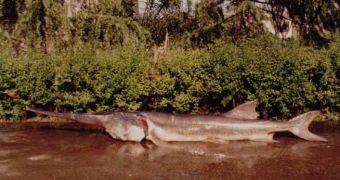Mekong giant catfish can reach 3 m (10 ft) in length and be 350 kg (780 pounds) and arapaima of the Amazon can be 4.5 m (15 ft) long. But all these "little" creatures are dwarfed by the Chinese paddlefish, a monster that is 23 feet (7 meters) long and weighs 500 kg (even if recorded data speak about 3.5 m (12 ft) in length and 300 kg in weight). Or at least were, as no adult Chinese paddlefish has been captured in the Yangtze River by fishers since 2003 and no young paddlefish has been sighted since 1995.
"When you don't see juveniles, we think maybe there's no spawning," said Wei Qiwei, head of the research laboratory at the Yangtze River Fisheries Research Institute in Jingzhou.
He and other researchers fear that even if adult paddlefish are encountered in the Yangtze, the species' future is bleak if they cannot reproduce, an irreversible path to extinction.
The Chinese paddlefish, also called elephant fish due to its elongated snout, eats fish and in smaller amounts crab and crayfish. They were highly prized and big individuals were commonly offered as gifts to the Chinese emperor. In the 1970s hundreds of paddlefish were captured annually from the Yangtze River.
"Then, in the 1980s, the population dropped dramatically," Wei said.
The giant Gehzouba hydroelectric dam, finished in 1983, divided the Yangtze River into two sections and disrupted the migratory route of the paddlefish.
"The paddlefish travel long distances, from their forage grounds in the middle and lower part of the Yangtze River-and sometimes the coastal waters-to their spawning grounds in the upper river. The dam separated the feeding area from the spawning ground." Wei said.
"The spawning process for paddlefish is particularly sensitive because females do not become sexually mature until they are seven or eight years old. The newly built Three Gorges Dam, the largest hydroelectric dam in the world, which sits 30 miles (48 kilometers) upriver from the Gezhouba Dam, has further reduced paddlefish habitat," he added.
Another two dams are planned on the upper course of the Yangtze River.
"The plight of the Chinese paddlefish underscores the urgent need to protect the river giants. Here is what is perhaps the world's largest freshwater fish, and it's close to extinction," said Zeb Hogan, head of the National Geographic Society's Megafishes Project, a three-year program to determine the conservation status of the world's largest freshwater fishes. "An 11 ft (3.3 m) paddlefish was caught by fishers in December 2002. It died after 29 days in captivity," said Wei.
In January 2003, a 12 ft (3.5 m) paddlefish was caught in Yibin in the upper Yangtze and during the eight hours till reaching Yibin, Wei gave suggestions to officials on how to handle the fish, which survived.
The individual was released back into the river, with a transmitter implanted. The signal was lost, but Wei thinks the fish is still alive.
"These fish can live for maybe 50 years. I'm sure it's still there. The upper Yangtze provides a possible last refuge for the fish and that there might be up to a dozen individuals left. That area has many deep pools and underwater caves where the fish can hide," he said.

 14 DAY TRIAL //
14 DAY TRIAL //